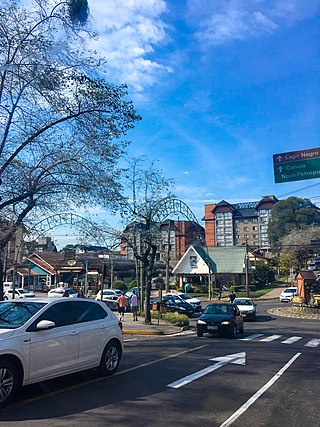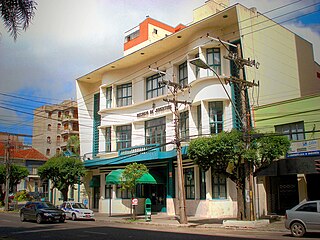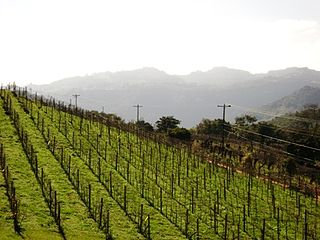
Rio Grande do Sul is a state in the southern region of Brazil. It is the fifth-most populous state and the ninth-largest by area. Located in the southernmost part of the country, Rio Grande do Sul is bordered clockwise by Santa Catarina to the north and northeast, the Atlantic Ocean to the east, the Uruguayan departments of Rocha, Treinta y Tres, Cerro Largo, Rivera, and Artigas to the south and southwest, and the Argentine provinces of Corrientes and Misiones to the west and northwest. The capital and largest city is Porto Alegre. The state has the highest life expectancy in Brazil, and the crime rate is relatively low compared to the Brazilian national average. Despite the high standard of living, unemployment is still high in the state, as of 2017. The state has 5.4% of the Brazilian population and it is responsible for 6.6% of the Brazilian GDP.

Jundiaí is a municipality in the state of São Paulo, in the Southeast Region of Brazil, located 57 kilometres (35 mi) north of São Paulo. The population of the city is 423,006, with an area of 431.21 km². The elevation is 761 m. The GDP of the city is U$16.6 billion. The budget for 2013 is U$787 million, according to the official data of the City Hall.

Caxias do Sul is a city in Rio Grande do Sul, Southern Brazil, situated in the state's mountainous Serra Gaúcha region. It was established by Italian immigrants on June 20, 1890. Today it is the second largest city in the state of Rio Grande do Sul. In 2020, the population of Caxias do Sul was estimated at 517,451 people, many of whom are of Italian and German descent. The demonym of the citizens of Caxias do Sul is Caxiense.

Jaraguá do Sul is a city in the north of the Brazilian state of Santa Catarina.

The Serra Gaúcha is a cultural region comprising the mountainous areas in the northeastern portion of Rio Grande do Sul state in southern Brazil. Most of its inhabitants are of German and Italian ancestry. Consequently, the cities in the Serra Gaúcha reflect German and Italian influences through their architecture, gastronomy, and culture. Geographically, it is part of the Serra Geral mountain range.

Farroupilha is a city in Rio Grande do Sul, Brazil, in the Serra Gaúcha between the cities of Bento Gonçalves and Caxias do Sul. The city's total area is 359.3 km2. Farroupilha has 73,061 residents.
Nova Bassano is a municipality and a city in the state of Rio Grande do Sul, south Brazil.

Grape festivals are celebrated as a tradition in various parts of the world. Many double as harvest festivals and celebrate wine making and other foods and beverages made from grapes.
This is a list of Brazilian television related events from 1972.

Events in the year 1972 in Brazil.

The history of Caxias do Sul, one of the main municipalities in the state of Rio Grande do Sul in Brazil, officially begins with the Italian colonization of the region, which started in 1875. However, indigenous tribes had lived there since ancient times, but were displaced to make way for the European settlers. The beginning of the settlement was difficult, being an area of thick virgin forest. However, quickly the forest was opened up and the first crops and livestock began to bear fruit. In 1890 trade was already flourishing and industries started to multiply. The primitive village, at the time a district of São Sebastião do Caí, was already showing signs of self-sufficiency enough to be emancipated, becoming a village governed by a provisional Council, and soon by a Municipal council and an Intendancy.

The 2021 Summer Deaflympics, officially known as the 24th Summer Deaflympics or XXIV Summer Deaflympics, and commonly known as Caxias Do Sul 2021, was an international multi-sport event held from 1 to 15 May 2022 in Brazil. The main host city was Caxias do Sul, Brazil, originally scheduled for December 2021 but postponed until May 2022 due to the COVID-19 pandemic. In addition to Caxias, there were events scheduled for the neighboring cities of Farroupilha and Flores da Cunha. In April 2022, CISS has announced that due to the Russian invasion of Ukraine, Russian and Belarusian athletes were barred from competing in Caxias do Sul, and in the same press release it was also announced that the bowling tournament was scheduled to be held in Kuala Lumpur, Malaysia, during October 2022.

The Historic Center of Caxias do Sul is a Special Sector of the city contemplated in its General Plan and regulated by specific legislation. It comprises the region that was first urbanized, located around the Dante Alighieri square and limited by the streets Os 18 do Forte, Bento Gonçalves, Alfredo Chaves, and Moreira César. The Historic Center has been the vital core of Caxias do Sul since its origin and has undergone profound changes since the early days, but it still preserves its original urban layout and a number of buildings of great architectural and historical interest. However, it has suffered from frequent traffic jams and the degradation of some stretches.

Italian immigration in Rio Grande do Sul was a process in which Italians emigrated to the southern state of Rio Grande do Sul, Brazil, through both private and government initiatives.

The Grape, Honey, Cheese, Ham and Handicraft Festival is a fair of agro-regional production in the Brazilian city of Ponta Grossa, in the state of Paraná.

Dante Alighieri Square is the oldest and most traditional public square in Caxias do Sul, Rio Grande do Sul, Brazil, located in the center of the city. It was included in the colony's floor plan from the beginning of the territory's occupation and was the stage for many important events, having in its surroundings several historical buildings of great importance.

João Spadari Adami was a Brazilian historian.

Giuseppe di Stefano Paternó was an Italian politician and lawyer active in the Brazilian state of Rio Grande do Sul at the beginning of the 20th century, as the main proponent and organizer of the cooperative movement.

Recreio da Juventude is a club in the Brazilian city of Caxias do Sul. Founded in 1912, it is one of the oldest and most traditional clubs in the city. It has engaged in intense social, cultural, recreational, and sports activities since its foundation; the Esporte Clube Juventude branched out from the club. Currently, the Recreio da Juventude has a social headquarters, a large countryside headquarters with sports and leisure equipment, and remains the owner of the building of the old Central Cinema, which although deactivated since 1990, was one of the main show houses in Caxias, offering cinema, theater, and music. It won several titles in sports and the Central Cinema and the social headquarters building are listed as a heritage site.

The Região da Uva e Vinho is a Brazilian tourist zone located in the northeast of the state of Rio Grande do Sul. It encompasses municipalities with the highest grape and wine production in the country. This condition has turned the region into one of the most important tourist hubs in Rio Grande do Sul, attracting hundreds of thousands of tourists from Rio Grande do Sul, other Brazilian states, and even other countries.

















